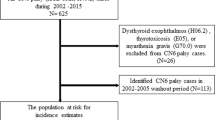Abstract
Purpose
The purpose of this study was to assess the role of neuroimaging in identifying the etiology of pediatric isolated sixth nerve palsy (SNP).
Methods
A retrospective cohort study was conducted of all patients younger than 18 years of age with an isolated SNP seen at our medical center between 2003 and 2011.
Results
Sixteen children (nine girls; mean age, 4.5 years) with isolated SNP were identified during an 8-year period. Only cases with normal optic disk appearance and otherwise normal neurological examination were included into this study. Thus, 12 other children with SNP were excluded: ten children with papilledema, one child who developed a SNP following a resection of a brain tumor, and one with hydrocephalus and a shunt malfunction. All cases of isolated SNP were unilateral (ten left eyes). The most common cause for the SNP in these children was a tumor that was found in five patients. Other etiologies encountered in decreasing frequencies were: benign recurrent SNP (in four children), postviral or vaccination (in three children), and one case each of post trauma, Chiari malformation, congenital, and undetermined. Children who were found to have a tumor (9.9 ± 5.5 years) were significantly older (P = 0.019) than children who did not have a tumor (2.1 ± 1.8 years).
Conclusions
Isolated SNP can be the presentation of a brain tumor in children, and therefore, early neuroimaging of the brain is recommended, especially in older children.

Similar content being viewed by others
References
Affifi AK, Bell WE, Menzes AH (1992) Etiology of lateral rectus palsy in infancy and childhood. J Child Neurol 7:295–299
Aroichane M, Repka MX (1995) Outcome of sixth nerve palsy or paresis in young children. J Pediatr Ophthalmol Strabismus 32:152–156
Brodsky MC (2010) Ocular motor nerve palsies in children. In: Pediatric neuro-ophthalmology, 2nd edn. Springer, New York, pp 281–293
Burde RM, Savino PJ, Trobe JD (1992) Diplopia. In: Clinical decisions in neuro-ophthalmology, 3rd edn. CV Mosby, Philadelphia, pp 171–172
Greenberg AE, Mohney BJ, Diehl NN, Burke JP (2007) Incidence and types of childhood esotropia. Ophthalmology 114:170–174
Harley RD (1980) Paralytic strabismus in children: etiologic incidence and management of the third, fourth, and sixth nerve palsies. Ophthalmology 83:24–43
Holmes JM, Mutyala S, Maus TL, Grill R, Hodge DO, Gray DT (1999) Pediatric third, fourth and sixth nerve palsies: a population-based study. Am J Ophthalmol 127:388–392
Kodsi SR, Younge BR (1992) Acquired oculomotor, trochlear, and abducent cranial nerve palsies in pediatric patients. Am J Ophthalmol 114:568–574
Lee MS, Galetta SL, Volpe NJ, Liu GT (1999) Sixth nerve palsies in children. Pediatr Neurol 20:49–52
Merino P, Gómez de Liaño P, Villalobo JM, Franco G, Gómez de Liaño R (2010) Etiology and treatment of pediatric sixth nerve palsy. J AAPOS 14:502–505
Robertson DM, Hines JD, Rucker CW (1970) Acquired sixth-nerve paresis in children. Arch Ophthalmol 83:574–579
Rucker CW (1958) Paralysis of the third, fourth and sixth cranial nerves. Am J Ophthalmol 46:787–794
Rucker CW (1966) The causes of paralysis of the third, fourth and sixth cranial nerves. Am J Ophthalmol 61:1293–1298
Author information
Authors and Affiliations
Corresponding author
Rights and permissions
About this article
Cite this article
Dotan, G., Rosenfeld, E., Stolovitch, C. et al. The role of neuroimaging in the evaluation process of children with isolated sixth nerve palsy. Childs Nerv Syst 29, 89–92 (2013). https://doi.org/10.1007/s00381-012-1929-z
Received:
Accepted:
Published:
Issue Date:
DOI: https://doi.org/10.1007/s00381-012-1929-z




